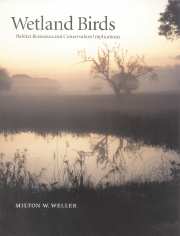Book contents
- Frontmatter
- Contents
- List of plates
- Preface
- Acknowledgments
- 1 Introduction
- 2 Wetlands: what, where, and why
- 3 Major groups of birds that use wetlands
- 4 Water and other resource influences
- 5 Foods, feeding tactics, strategies, and guilds
- 6 Bird mobility and wetland predictability
- 7 Other behavioral and physical influences on wetland living
- 8 Spatial and structural patterns
- 9 Habitat dynamics: water, plant succession, and time
- 10 Population consequences of wetland abundance and quality
- 11 How birds influence wetlands
- 12 Conservation implications
- 13 Measures of bird habitat use and quality
- 14 Current status and some conservation problems
- 15 Conservation and management strategies
- 16 Outlook
- 17 Epilogue
- Appendix 1 Scientific names of birds and bird groups
- Appendix 2 Scientific names of animals and animal groups other than birds
- Appendix 3 Scientific names of plants and plant groups
- Index of birds and bird groups
- Subject index
12 - Conservation implications
Published online by Cambridge University Press: 02 October 2009
- Frontmatter
- Contents
- List of plates
- Preface
- Acknowledgments
- 1 Introduction
- 2 Wetlands: what, where, and why
- 3 Major groups of birds that use wetlands
- 4 Water and other resource influences
- 5 Foods, feeding tactics, strategies, and guilds
- 6 Bird mobility and wetland predictability
- 7 Other behavioral and physical influences on wetland living
- 8 Spatial and structural patterns
- 9 Habitat dynamics: water, plant succession, and time
- 10 Population consequences of wetland abundance and quality
- 11 How birds influence wetlands
- 12 Conservation implications
- 13 Measures of bird habitat use and quality
- 14 Current status and some conservation problems
- 15 Conservation and management strategies
- 16 Outlook
- 17 Epilogue
- Appendix 1 Scientific names of birds and bird groups
- Appendix 2 Scientific names of animals and animal groups other than birds
- Appendix 3 Scientific names of plants and plant groups
- Index of birds and bird groups
- Subject index
Summary
Wetland birds differ widely in their species composition and relative abundance within a community, but we lack thorough studies of communities in many wetland types and at various temporal scales. In addition to helping us to understand how such systems function, these data provide a basis for measuring change and evaluating impacts of natural and societal influences and, therefore, are important in conservation efforts. The purpose of this chapter is to summarize some of the patterns of habitat use by wetland birds and their potential biological properties, outlined above, and generalize on their relationship to conservation and management. Conserving wetland birds also requires an understanding of their relationships to society, because human populations do not have an impact on all groups of wetland birds uniformly (Weller 1988a). Moreover, some wetland types are more at risk than others because of alternative human uses, which will have a secondary effect on the success of birds there (Krapu et al. 1997).
Interest in wetland bird conservation often has focused on single species or taxonomic groups that have been of interest or importance for esthetic, recreational, or food values, and efforts to maintain populations have been funded by user-fees (e.g., hunting, bird watching). The use of general tax appropriations is less common except for those species that are especially rare; this has been an area of increasing concern because of the role that society has played in extirpations and extinctions.
- Type
- Chapter
- Information
- Wetland BirdsHabitat Resources and Conservation Implications, pp. 189 - 198Publisher: Cambridge University PressPrint publication year: 1999



